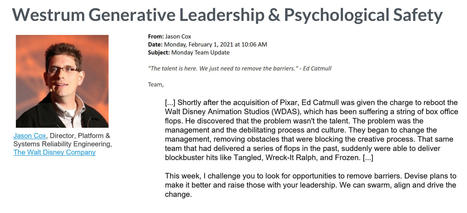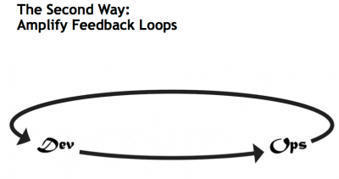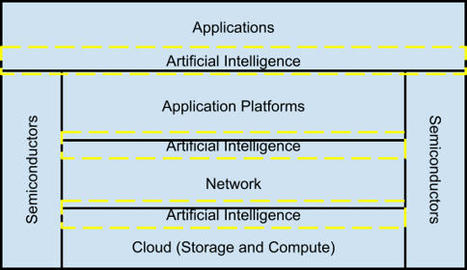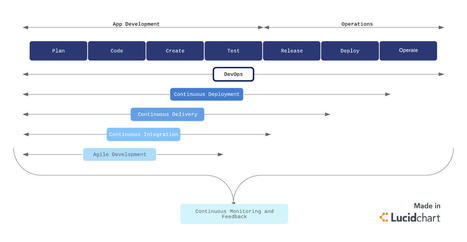 Your new post is loading...
 Your new post is loading...

|
Scooped by
Mickael Ruau
October 8, 2021 6:35 AM
|
Ce rapport est r�alis� par l'�quipe Google Cloud�s DevOps Research and Assessment (DORA).
Il tente de r�pondre aux questions suivantes :
Comment les �quipes logicielles les plus performantes se distinguent-elles des �quipes moins performantes ?

|
Scooped by
Mickael Ruau
September 30, 2021 12:40 AM
|
Le récit est décomposé en 3 étapes principales : – Rendre plus lisible et modulaire la base de code et la retranscrire dans une logique métier. – Introduire la boîte à outils Accelerate. – Initier une démarche qui fait écho à Accelerate et s’est nourrie du travail réalisé par les 2 coachs sur l’approche Domain-Driven Design et Software craftsmanship Vous verrez qu’au travers de l’article, c’est une combinaison de plusieurs facteurs qui permet d’arriver aux résultats actuels.

|
Scooped by
Mickael Ruau
September 16, 2021 9:09 AM
|
Le pattern « feature flipping » permet d’activer et désactiver des fonctionnalités directement en production, sans re-livraison de code. Plusieurs termes sont utilisés par les grands du web : Flickr et Etsy utilisent des « feature flags », Facebook des « gatekeepers », Forrst des « feature buckets », des « features bits » chez Lyris inc., alors que Martin Fowler opte pour des « feature toggles ». Bref, chacun le nomme et l’implémente à sa manière mais dans l’idée toutes ces techniques rejoignent les mêmes objectifs. Dans cet article, nous utiliserons le terme « feature flipping ». Mis en œuvre avec succès sur notre solution de store privé Appaloosa, cette technique a apporté de nombreux bénéfices pour quelques inconvénients.

|
Scooped by
Mickael Ruau
September 15, 2021 2:10 AM
|
Dégustez ce serious game qui vous fera découvrir Accelerate (La science derrière DevOps). Le jeu vous montrera comment activer accelerate !

|
Scooped by
Mickael Ruau
September 10, 2021 7:56 AM
|
Le DevOps est le meilleur moyen de développer, de livrer et de maintenir des applications. Les entreprises qui adoptent le DevOps sont plus rapides et suivent l’évolution des demandes des clients. Toutefois, la création d’une culture agile, réactive, orientée données, ainsi que les processus qui la soutiennent, est plus facile à dire qu’à faire.

|
Scooped by
Mickael Ruau
August 30, 2021 1:19 AM
|

|
Scooped by
Mickael Ruau
August 27, 2021 9:51 AM
|
Ten years ago, the idea of DevOps sprang from the minds of Andrew Shafer and Patrick Debois (source). A year later they actually named it “DevOps”. This tenth anniversary marks a good time to look at where DevOps has taken us as an industry and where we are heading. This write up is not about vendors, commercial, open source or otherwise. At least not exclusively. This post looks back at the history of DevOps and CI/CD practices and digs into what patterns have evolved over the years and what patterns we see coming over the horizon.

|
Scooped by
Mickael Ruau
August 19, 2021 1:26 AM
|
A recent Software Delivery Leadership Forum panel discussion shared approaches and tactics for creating a successful DevOps culture. The panel stressed the importance of an aligned culture around the DevOps adoption. This includes setting strategic organizational goals, cultivating psychological safety, and treating your culture as a product.

|
Scooped by
Mickael Ruau
August 17, 2021 8:15 AM
|
Learn about trunk-based development, a version control management practice where developers merge small, frequent updates to a core “trunk” or main branch

|
Scooped by
Mickael Ruau
August 6, 2021 1:19 AM
|
This keynote is a toolbox designed to help you bring proper implementation of devops and to make people work together on a common goal: efficient automatisation and use of the human brain power geared towards making IT an asset instead of a cost center.

|
Scooped by
Mickael Ruau
July 18, 2021 7:41 AM
|

|
Scooped by
Mickael Ruau
July 7, 2021 1:30 AM
|
The Three Ways describe the values and philosophies that frame the processes, procedures, and practices of DevOps.

|
Scooped by
Mickael Ruau
June 28, 2021 1:48 AM
|
Kanban is nothing new; in fact, it predates most readers of this article. Its age becomes apparent when we add the year Toyota introduced kanban in its main plant machine shop (1953) to the timeline image from our analyzing the DNA of DevOps article.
|

|
Scooped by
Mickael Ruau
October 5, 2021 8:15 AM
|
The full report is 45 pages long. It’s worth a read if you can spare the time. But in case you can’t, we’ve pulled out the most important takeaways for SREs -- who have much to learn from the DORA findings, even if the official focus of the report is on DevOps and not SRE.
You Don’t Need SRE or DevOps. You Need SRE and DevOps
Probably the most significant finding is that DevOps and SRE aren’t an either-or proposition. Although some folks conflate these domains, or assume that one is more important than the other, Google says modern organizations need both SRE and DevOps.
“SRE and DevOps are highly complementary, and our research demonstrates their alignment,” according to the report, which added, “SRE drives DevOps success.”

|
Scooped by
Mickael Ruau
September 22, 2021 1:18 AM
|
Constructing a DevOps pipeline is an essential part of a software architect's process when working in a software engineering team. In the past, as I participated as a technical interviewer at Red Hat, I was quite surprised to find very few people could clearly describe what a DevOps pipeline is and what a Continuous Integration and Continuous Deployment (CI/CD) pipeline is. You will understand what these pipelines are by reading this article.

|
Scooped by
Mickael Ruau
September 16, 2021 8:27 AM
|
On ne fait pas du DevOps parce que c’est hype ! Parfois, ce n’est pas pertinent et on est les premiers à le dire. Il y a aussi un énorme travail sur l’accompagnement des personnes qui vont utiliser les outils. Il faut mettre le paquet sur l’humain et cela manque encore. Nos livres permettent d’éliminer les premiers mauvais choix (d’organisation, d’outils, de pratiques…). C’est un premier niveau d’écrémage ; on ne prétend pas tout résoudre, mais nous posons au moins des bases saines.

|
Scooped by
Mickael Ruau
September 10, 2021 8:02 AM
|
DevOps emerged as an important extension to support the Agile development for frequent and continuous software delivery. The adoption of Agile-DevOps for large scale enterprise agility depends on the most important human capability such as people competency and experience. Hence, academic education and professional training is key to the successful adoption of Agile-DevOps approach. Thus, education and training providers need to teach Agile-DevOps. However, the challenge is: how to establish and simulate an effective Agile-DevOps technology environment for teaching Enterprise Agile? This paper introduces the integrated Adaptive Enterprise Project Management (AEPM) and DevOps Reference Architecture (DRA) approach for adopting and teaching the Agile-DevOps with the help of a teaching case study from the University of Technology - Sydney (UTS), Australia. These learnings can be utilised by educators to develop and teach practice-oriented Agile-DevOps for software engineering courses. Furthermore, the experience and observations can be employed by researchers and practitioners aiming to integrate Agile-DevOps at the large enterprise scale.

|
Scooped by
Mickael Ruau
September 10, 2021 7:53 AM
|
The role and structure of an enterprise architecture in a DevOps environment comes down to developing a common culture and connnecting processes and tools.

|
Scooped by
Mickael Ruau
August 30, 2021 1:12 AM
|
The panelists discuss some of the most fun and least fun moments coding, how functional programming practices have helped, and how productivity can be unleashed at a team-of-teams scale.

|
Scooped by
Mickael Ruau
August 19, 2021 1:55 AM
|
Keeping in touch and being cohesive as a distributed team is a challenge many face. Assigning stories from a shared backlog helped a distributed team in doing non-stop delivery, as did giving all members of the team the authority to promote to production and back-out code at need. You need to give attention to the architecture to prevent creating similar or duplicate micro-services.

|
Scooped by
Mickael Ruau
August 19, 2021 1:23 AM
|
Measuring the four key metrics of IT helped a company to assess the performance of their software delivery process. Continuous observation of these metrics supports decisions on where to invest and guides performance improvements.

|
Scooped by
Mickael Ruau
August 10, 2021 1:34 AM
|
Context The last two decades have completely changed the technology (tech) sector. Cloud computing , smartphones, apps, an

|
Scooped by
Mickael Ruau
July 23, 2021 3:28 AM
|
Puppet State of DevOps Report 2021 marks the 10th anniversary of the State of DevOps Report. This blog post reviews the key findings.

|
Scooped by
Mickael Ruau
July 12, 2021 3:08 AM
|
Trois octos, trois expertises, trois tribus. Ces tribus, OPS, NAD (Nouvelles Architectures de Données) et CNA (Cloud Native Application) sont d’ailleurs réunies sous un même pôle (La Forge) chez OCTO. Alors de quelle manière ces trois métiers peuvent se rencontrer sur une même mission ? Aryana, Robin et Thomas viennent nous en parler !

|
Scooped by
Mickael Ruau
July 7, 2021 1:28 AM
|
Learn about the benefits and lifecycle of DevOps and see how your organization can adopt a successful DevOps process flow.
|
 Your new post is loading...
Your new post is loading...
 Your new post is loading...
Your new post is loading...

















![[PDF] An Agile-DevOps Reference Architecture for Teaching Enterprise Agile | Semantic Scholar | Devops for Growth | Scoop.it](https://img.scoop.it/f_jpH3XqJVrCEPBsgTEIdDl72eJkfbmt4t8yenImKBVvK0kTmF0xjctABnaLJIm9)












